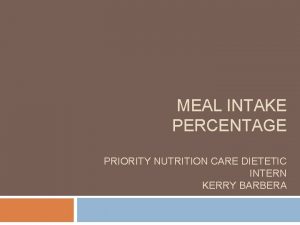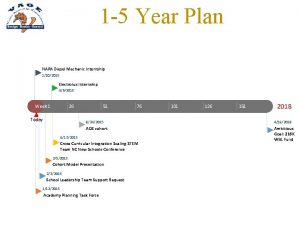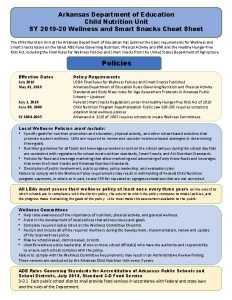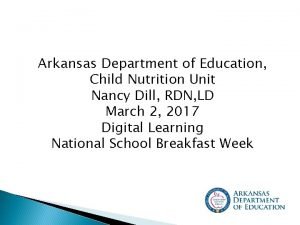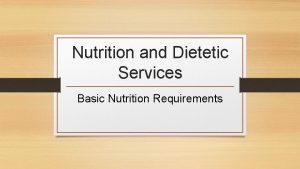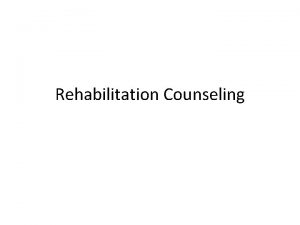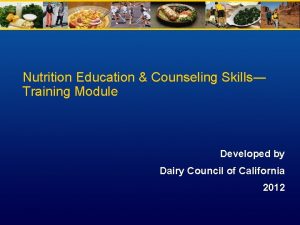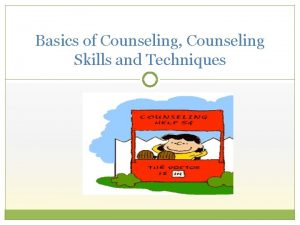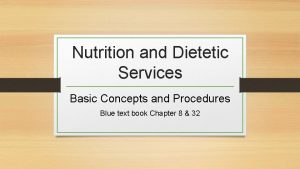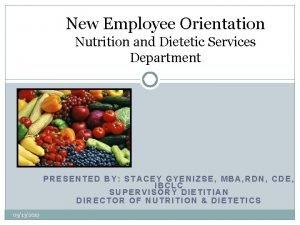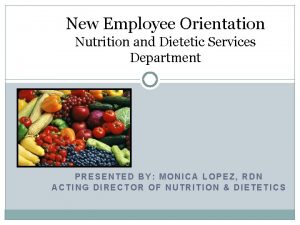Nutrition Counseling and Education Skills for Dietetic Professionals

























- Slides: 25

Nutrition Counseling and Education Skills for Dietetic Professionals 6 th Edition Copyright © 2014 Wolters Kluwer Health | Lippincott Williams & Wilkins

Chapter 5 Stages and Processes of Health Behavior Change Copyright © 2014 Wolters Kluwer Health | Lippincott Williams & Wilkins

Objectives • Explain the steps in goal setting process and practice them with a client • Explain the five stages of change • Identify one process appropriate for each stage of change • Discuss the decisional balance and how it should be used • Describe the impact of self-efficacy on behavior change. Copyright © 2014 Wolters Kluwer Health | Lippincott Williams & Wilkins

Transtheoretical Model (TTM) • TTM draws on other theories • Purpose is to guide the timing and content of interventions • Composed of a number of constructs including Stages of Change Copyright © 2014 Wolters Kluwer Health | Lippincott Williams & Wilkins

Stages of Change • Precontemplation – unaware of a problem and has no intention to change • Contemplation –aware that there is a problem but with no serious plan to change Copyright © 2014 Wolters Kluwer Health | Lippincott Williams & Wilkins

Stages of Change (con’t) • Preparation –determined to change but has no plan of action • Action –attempts to implement a plan of action for at least 6 months • Maintenance – has implemented a plan for several months and new behaviors are becoming automatic Copyright © 2014 Wolters Kluwer Health | Lippincott Williams & Wilkins

Stages of Change (con’t) • Termination – is the ultimate goal in which changes have been followed for several years. Some never reach this stage • Recycling – going back and forth through the stages Copyright © 2014 Wolters Kluwer Health | Lippincott Williams & Wilkins

Process of Change • Ten activities used to progress through the stages of change • Processes are cognitive and behavioral activities with specific task and goals to change thoughts and behaviors Copyright © 2014 Wolters Kluwer Health | Lippincott Williams & Wilkins

Process of Change (con’t) 1. Consciousness raising – increases awareness to the consequences 2. Dramatic Relief –increases emotional awareness 3. Self-reevaluation – includes both cognitive and affective reassessment of self-image Copyright © 2014 Wolters Kluwer Health | Lippincott Williams & Wilkins

Process of Change (con’t) 4. Environmental reevaluation – affects on social climate 5. Self-liberation – belief that one can change and commitment to act 6. Social liberation – increases social alternatives and opportunities 7. Counterconditioning – changing behavior in response to activities Copyright © 2014 Wolters Kluwer Health | Lippincott Williams & Wilkins

Process of Change (con’t) 8. Stimulus control – removes environmental cues 9. Contingency management – positive reinforcement and rewards 10. Helping relationships – support for behavior change Copyright © 2014 Wolters Kluwer Health | Lippincott Williams & Wilkins

Matching Processes to Stages • Examples: – Precontemplation stage may include the process of consciousness raising and selfreevaluation – Contemplation stage may include the process of continued consciousness raising and environmental reevaluation Copyright © 2014 Wolters Kluwer Health | Lippincott Williams & Wilkins

Matching Processes (con’t) • Stages continued – Preparation stage may include stimulus control, self-liberation, and counterconditioning – Action stage may include stimulus control and contingency management Copyright © 2014 Wolters Kluwer Health | Lippincott Williams & Wilkins

Decisional Control • A method for weighing pros and cons of changing, advantages with barriers Copyright © 2014 Wolters Kluwer Health | Lippincott Williams & Wilkins

Goal Setting • New behaviors may be enhanced by specific goals • Based on client’s willingness to change and taking an active role in change • Four steps used in goal setting: 1. goal identification; 2. goal importance and acceptance; 3. goal analysis and overcoming obstacles; 4. goal implementation Copyright © 2014 Wolters Kluwer Health | Lippincott Williams & Wilkins

Step 1: Goal Identification • Goals are specific, measurable, attainable, timely • Goals should be small steps • Goals can be motivating • Start with 1 -2 easy goals for client Copyright © 2014 Wolters Kluwer Health | Lippincott Williams & Wilkins

Step 2: Goal Importance and Acceptance • Assess goal importance on numerical scale (1 -10) • Pick goals of high importance to client Copyright © 2014 Wolters Kluwer Health | Lippincott Williams & Wilkins

Step 3: Goal Analysis and Overcoming Obstacles • Discuss problems in achieving goals • Discover and help overcome obstacles Copyright © 2014 Wolters Kluwer Health | Lippincott Williams & Wilkins

Step 4: Goal Implementation • Discuss specific steps person will take • Provide nutrition information • Client compares performance to goals • Attaining goals is motivating, increases selfefficacy • Falling short decreases self-efficacy Copyright © 2014 Wolters Kluwer Health | Lippincott Williams & Wilkins

Some Information to Provide • Reading food labels • Adapting recipes, new recipes • Menu planning • Food purchasing & preparation • Restaurant/take out meals Copyright © 2014 Wolters Kluwer Health | Lippincott Williams & Wilkins

Information to Provide (con’t) • Healthful eating • Food safety • Nutrient-drug interactions • Exercise • Self-monitoring, self-management Copyright © 2014 Wolters Kluwer Health | Lippincott Williams & Wilkins

NCP Step 4: Nutrition Monitoring and Evaluation • Review & measure progress (outcomes) at intervals • Evaluate degree of progress, goals, outcomes • Modify recommendations if needed • Identify benefits in outcome data Copyright © 2014 Wolters Kluwer Health | Lippincott Williams & Wilkins

Examples of Outcomes (Improvements) • Knowledge gained, behavioral changes • Weight changes, blood pressure • Lipid/lab values, glycemic control • Dietary/lifestyle changes • Self-management, self-efficacy Copyright © 2014 Wolters Kluwer Health | Lippincott Williams & Wilkins

Documentation • Standards set by Joint Commission (JCAHO) • Document problems, etiology, signs/symptoms (PES) • DCP and ADI – nutrition diagnosis • Document interventions/outcomes of nutrition care • List discharge instructions, referrals Copyright © 2014 Wolters Kluwer Health | Lippincott Williams & Wilkins

Electronic Communication • Internet , email and telephone communication • Client’s informed consent and agreement for the use and disclosure of protected health information is needed. Copyright © 2014 Wolters Kluwer Health | Lippincott Williams & Wilkins
 Meal percentage intake chart
Meal percentage intake chart Nutrition for foodservice and culinary professionals
Nutrition for foodservice and culinary professionals Nutrition for foodservice and culinary professionals
Nutrition for foodservice and culinary professionals Nutrition for foodservice and culinary professionals
Nutrition for foodservice and culinary professionals Collaboration skills for school professionals
Collaboration skills for school professionals Training for higher education professionals
Training for higher education professionals Dietetic support worker
Dietetic support worker Csulb dietetic internship
Csulb dietetic internship Viterbo dietetic internship
Viterbo dietetic internship Sodexo distance dietetic internship
Sodexo distance dietetic internship Keiser university distance dietetic internship
Keiser university distance dietetic internship Wladek minor uva
Wladek minor uva Cal poly pomona dietetic internship
Cal poly pomona dietetic internship Texas student dietetic association
Texas student dietetic association Montclair dietetic internship
Montclair dietetic internship Dietetic internships in georgia
Dietetic internships in georgia Dietetic internships in georgia
Dietetic internships in georgia Sodexo dietetic internship
Sodexo dietetic internship Mechanic task 1
Mechanic task 1 Pengertian interpersonal skill
Pengertian interpersonal skill What are skills
What are skills Child nutrition unit arkansas
Child nutrition unit arkansas Child nutrition unit arkansas
Child nutrition unit arkansas Nebraska department of education nutrition services
Nebraska department of education nutrition services Strategic and competitive intelligence professionals scip
Strategic and competitive intelligence professionals scip Families professionals and exceptionality
Families professionals and exceptionality
